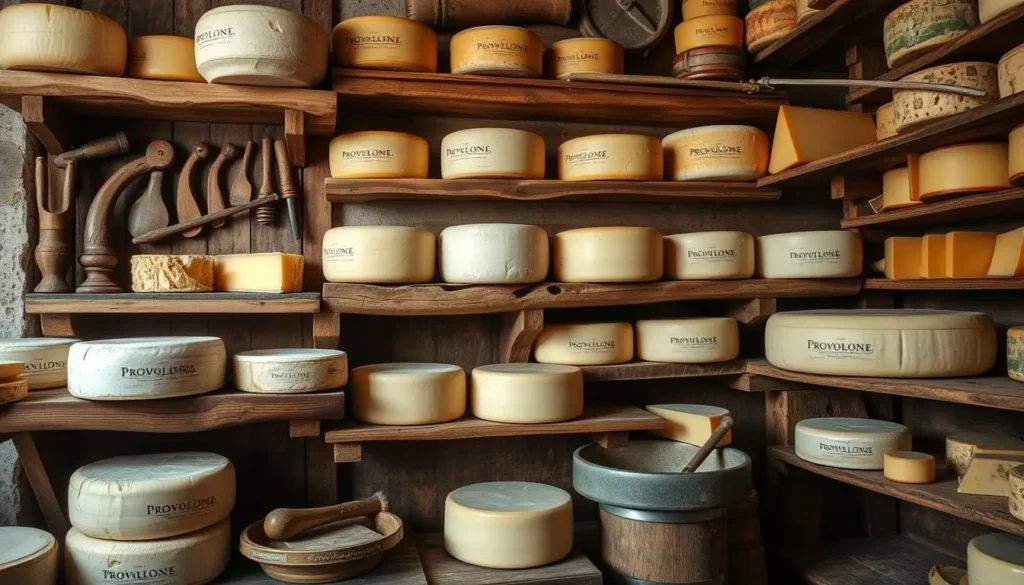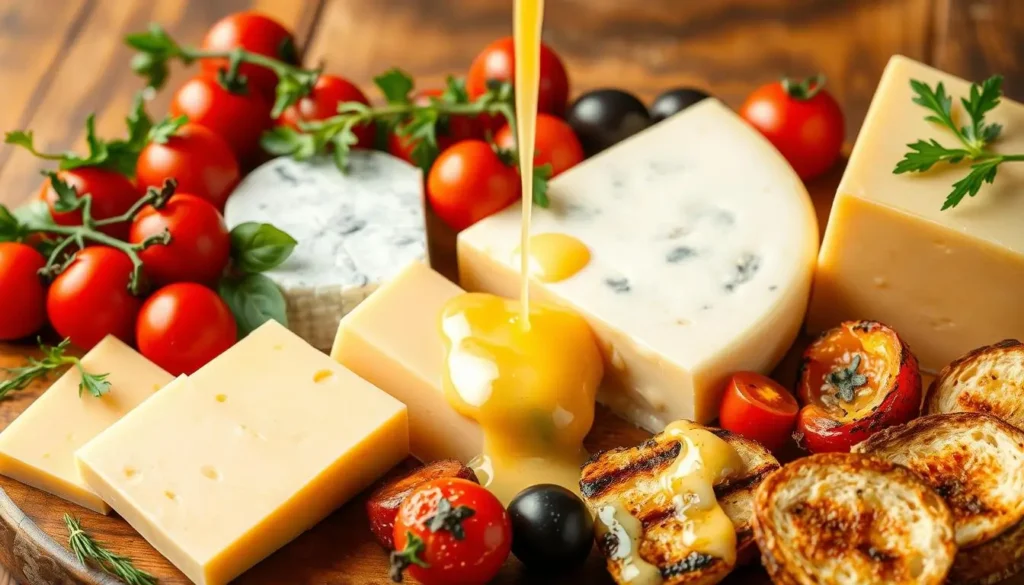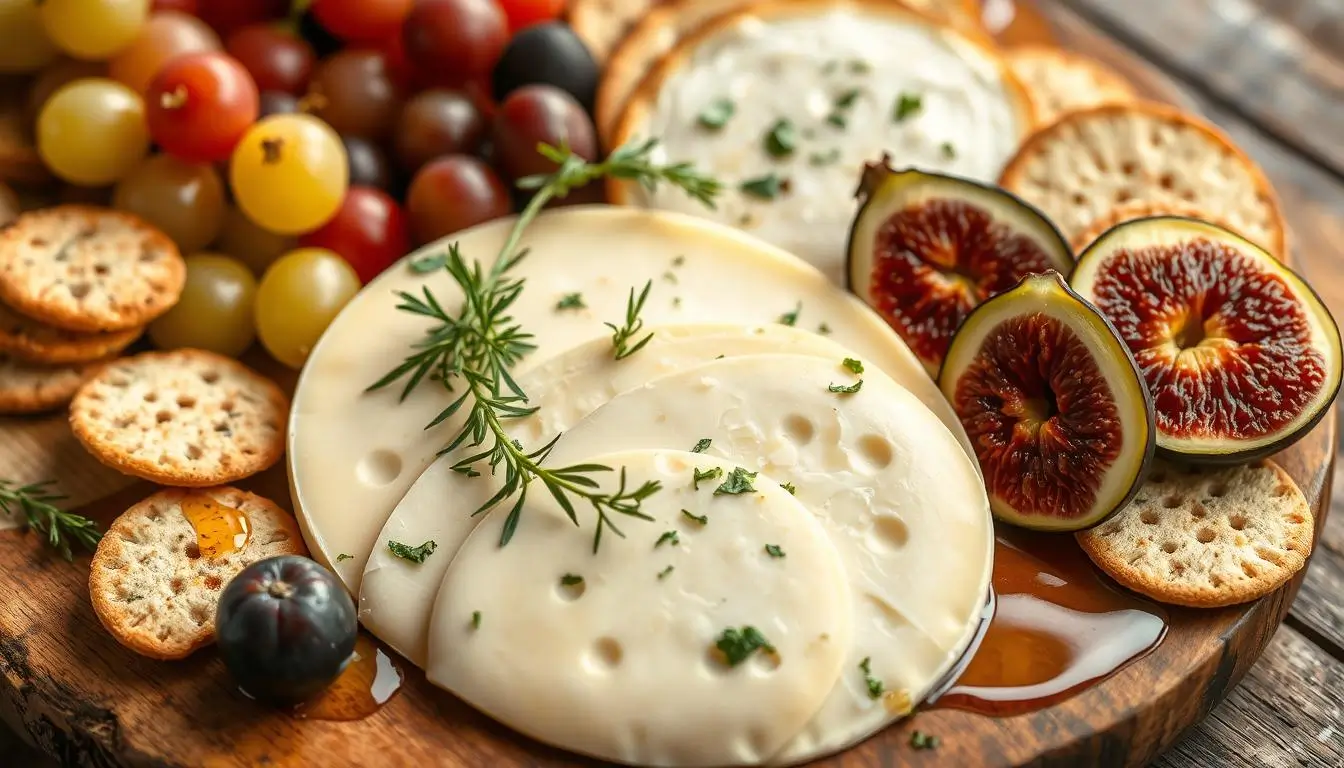Table of Contents
magine biting into a pizza with melted provolone cheese. The provolone cheese taste is amazing. You might ask, what does provolone cheese taste like? It’s a semi-hard, smooth Italian cheese with a mild, buttery flavor. This cheese can make your meals, from pasta to pizzas, even better.
Exploring provolone cheese opens up a world of flavors. You’ll learn about its rich history and how it’s made. The provolone cheese taste is a mix of flavors that can change your favorite dishes. Whether you love cheese or want to try something new, the provolone cheese taste is worth checking out.
Key Takeaways
- Provolone cheese has a mild, buttery flavor that can elevate your meals
- The provolone cheese taste is a perfect blend of flavors that can add a new dimension to your favorite dishes
- Provolone cheese is a semi-hard, smooth Italian cheese with a rich history and production methods
- You can use provolone cheese in a variety of dishes, from pasta to pizzas
- Exploring the world of provolone cheese can help you discover new flavors and recipes
- Understanding what does provolone cheese taste like can help you appreciate its unique characteristics
The Rich Heritage of Provolone Cheese
Provolone cheese has a long history in Italy. Its making involves choosing the best milk and aging it carefully, which directly impacts the exquisite provolone cheese taste. This process shows Italy’s deep love for dairy.
Making Provolone cheese is a detailed process. It starts with picking the right milk and ends with aging it perfectly, which enhances the provolone cheese taste. Italy is known for its cheese-making skills, and Provolone is a prime example of their craftsmanship.
Italian Origins and Traditional Production
In Italy, Provolone cheese is made the old way. It’s made from cow’s milk, which is full of nutrients and taste. The milk is heated, rennet is added, and then it’s shaped into its unique form.
The cheese is aged for at least two months. This is when it gets its special flavor and texture.

Evolution of Provolone Making
Over time, making Provolone cheese has changed a bit. But the old ways are still kept. The focus is on using top-notch milk and aging it just right.
Whether you love cheese or are new to it, Provolone is a treat. It’s a true taste of Italy.
| Traditional Production Methods | Modern Production Methods |
|---|---|
| Heating milk to 90°F | Pasteurization |
| Adding rennet | Using microbial rennet |
| Aging for 2-3 months | Aging for 2-12 months |
Modern Production Methods
Now, Provolone cheese is made with both old and new ways. Some stick to the traditional methods, while others use new tech. This mix makes the cheese-making process better and more consistent, while preserving the distinctive provolone cheese taste.
But the core of Provolone cheese stays the same. It’s still loved for its rich provolone cheese taste and smooth texture.
Understanding the Provolone Cheese Taste Profile
Wondering what provolone cheese tastes like? The provolone cheese taste is mild and buttery, with hints of fruit and nuts. The flavor can change based on its age and how it’s made. Exploring provolone, you’ll find its taste is both rich and complex.
The provolone cheese taste is smooth and creamy, with a touch of sweetness. As it ages, it gets even more flavorful, with caramel and toasted nut notes. Its aroma is also unique, with a sweet and nutty scent. Enjoying provolone alone or with others, the provolone cheese taste is always a pleasure.
Some key characteristics of provolone cheese include:
- A mild, buttery flavor with notes of fruit and nuts
- A smooth and creamy texture
- A distinctive aroma with a slightly sweet and nutty scent

Trying provolone cheese, you’ll see its versatility and richness. Its unique taste and smooth texture make it perfect for many dishes. From pasta and pizza to salads and sandwiches, provolone is a hit. So, what does provolone cheese taste like? It’s a delicious and unforgettable experience that will leave you wanting more.
Different Ages of Provolone and Their Flavors
Provolone cheese’s flavor changes with age. This is key when wondering if the provolone cheese taste is like mozzarella. The aging time impacts its taste, texture, and smell. This makes provolone versatile for many dishes.
As provolone ages, its taste gets stronger. You can find provolone at various ages, each with its own provolone cheese taste. Aging can last from a few months to several years, offering a range of flavors.
Mild Provolone Characteristics
Mild provolone is aged for 2-3 months. It’s smooth, creamy, and tastes mildly buttery. It’s great for snacking, grating, or in sandwiches.
Sharp Provolone Qualities
Sharp provolone ages for 6-12 months. It’s richer and has a firmer texture. It’s perfect for grating over pasta, salads, or in recipes needing a strong flavor.
Extra-Sharp Aged Varieties
Extra-sharp provolone ages for 2-3 years. It has a very strong, sharp taste and a crumbly texture. It’s great for those who like intense flavors and is used sparingly in dishes.
| Age | Flavor Profile | Texture |
|---|---|---|
| Mild (2-3 months) | Mild, buttery | Smooth, creamy |
| Sharp (6-12 months) | Rich, pronounced | Firm |
| Extra-Sharp (2-3 years) | Strong, sharp | Crumbly |
How to Best Store Your Provolone Cheese
To keep your provolone cheese fresh, it’s key to store it right. You need to watch the temperature, humidity, and how you wrap it. Keep it in a cool, dry spot to stop it from going bad and keep its texture good.
Here are some tips for storing provolone cheese:
- Keep it away from direct sunlight and heat sources
- Store it in a sealed container or plastic wrap to maintain humidity
- Refrigerate it at a temperature between 35°F and 40°F (2°C and 4°C)
- Freeze it for longer storage, but make sure to wrap it tightly to prevent freezer burn
Proper care of your provolone cheese is vital to keep its provolone cheese taste and texture. By following these tips, you can enjoy your provolone cheese taste longer. Always check the cheese for any signs of spoilage before eating it.
When storing provolone cheese, think about the type you have. For example, aged provolone might need different storage than younger cheese. Learning about storing provolone cheese helps keep the provolone cheese taste fresh and tasty.
In summary, storing provolone cheese needs careful attention and proper care. By following these tips and knowing your cheese type, you can enjoy the provolone cheese taste longer and keep its quality and flavor.
| Storage Method | Temperature | Humidity |
|---|---|---|
| Refrigeration | 35°F – 40°F (2°C – 4°C) | 50% – 60% |
| Freezing | 0°F (-18°C) or below | N/A |
Provolone vs. Mozzarella: A Taste Comparison
Italian cheeses like Provolone and Mozzarella are often compared. You might ask, does provolone taste like mozzarella? Both cheeses have unique traits but can be used in similar dishes. Knowing the differences helps when cooking and pairing them with other ingredients.
Provolone is smoother and more pliable than mozzarella. It’s great for slicing and serving alone or on charcuterie boards. Mozzarella, with its softer texture, is ideal for melting and stretching, like on pizzas or in caprese salads.
Key Differences in Flavor and Texture
- Provolone has a richer, more nuanced flavor, with caramel and nut notes. Mozzarella is milder and creamier.
- Provolone is aged, which intensifies its flavors. Mozzarella is usually fresh.
- Choose the cheese that fits your dish’s flavor intensity when comparing provolone vs mozzarella.
The choice between provolone and mozzarella depends on your taste and recipe. Understanding each cheese’s unique qualities helps you create delicious, authentic Italian dishes. This way, you can enjoy the best of provolone and mozzarella.
Creating the Perfect Provolone Pizza Experience
To make the perfect provolone cheese pizza, start with a great recipe. Provolone cheese adds a rich, creamy flavor. It’s key to pick the right toppings and sauces to go with it.
Here are some tips for the perfect provolone pizza:
- Use high-quality provolone cheese that’s freshly sliced
- Choose a sauce that goes well with the cheese, like a light tomato sauce or creamy pesto
- Add fresh veggies, like bell peppers or onions, for texture and taste
- Use a crispy crust that can hold the toppings and cheese
A classic provolone pizza recipe has provolone cheese, tomato sauce, and fresh basil. You can add meat, like pepperoni or sausage, for more flavor. Make sure the crust is crispy and the cheese is melted and bubbly.
Follow these tips and use a good recipe to make a delicious provolone cheese pizza. It will impress your family and friends. So, try it out and enjoy the perfect provolone pizza experience!
Pairing Provolone with Other Foods
There are countless ways to enjoy provolone cheese. You can have it alone or with many foods and drinks. Pairing it with other ingredients can make its taste even better. A great way to enjoy it is with wine, as it pairs perfectly.
Wine and Beverage Combinations
Provolone cheese goes well with different wines like Chardonnay, Merlot, and Pinot Grigio. For a casual event, try it with beer or cider. The goal is to match the cheese’s richness with the drink’s acidity.
Complementary Foods
Here are some foods that go well with provolone cheese:
- Fresh fruit, such as apples or grapes
- Cured meats, like prosciutto or salami
- Crackers or bread, for a quick snack
These can be mixed to make a charcuterie board with provolone cheese at the center.
Charcuterie Board Ideas
To make a charcuterie board, start with provolone cheese and other cheeses. Add cured meats, crackers, and fruit. Finish with nuts or chocolates. This mix offers a variety of tastes and textures, letting guests enjoy provolone with their favorites.
Cooking and Melting Properties of Provolone
Provolone cheese is perfect for cooking because it melts well. You can use it in sauces, soups, and baked dishes. It keeps its taste and texture. Melting it adds creaminess and richness to your food.
To melt provolone cheese, use low heat and stir often. Mixing it with mozzarella or parmesan can create a special flavor. Think about the dish you’re making and how much you want it to melt.
- Use provolone in sauces and soups for a creamy texture
- Melt provolone in baked dishes, such as lasagna or pizza, for a golden-brown crust
- Experiment with different melting techniques, such as grilling or pan-frying, to add a crispy texture to your dishes
Learning how to cook with provolone cheese can make your dishes amazing. It’s great for both experienced cooks and beginners. Adding provolone to your meals brings a bit of Italy to your kitchen.
Health Benefits and Nutritional Value
Exploring Provolone cheese reveals its nutritional value and health benefits. It’s packed with protein, calcium, and other key nutrients. These make it a great choice for a healthy diet. When eaten in moderation, it adds value to your meals.
Some of the key nutrients found in Provolone cheese include:
- Protein: essential for building and repairing muscles
- Calcium: crucial for maintaining strong bones and teeth
- Vitamins and minerals: such as vitamin A, vitamin B12, and phosphorus
Here are some tips for adding Provolone cheese to your diet:
- Pair it with fruits and nuts for a satisfying snack
- Use it in salads for a boost of protein and calcium
- Add it to your favorite pasta dishes for an extra layer of flavor
Knowing the health benefits and nutritional value of Provolone cheese helps you make better choices. Its rich flavor and health perks make it a great part of a balanced diet.
Popular Provolone Cheese Recipes
Provolone cheese is great for many recipes, like pasta, pizzas, and sandwiches. It makes a variety of tasty meals. Here are some popular recipes to try:
Some ideas for cooking with provolone include:
- Pasta bakes, such as lasagna or ziti
- Pizzas, including classic margherita or meat-lovers
- Grilled cheese sandwiches, paired with ham or turkey
- Cheesy dips, such as spinach and artichoke or queso
These recipes show how versatile provolone cheese is. Its smooth, buttery taste adds to any meal. Try new recipes to find your favorite.
How to Select Quality Provolone at the Store
When you’re buying provolone cheese, knowing what to look for is key. This ensures you get a high-quality product. Start by checking the cheese’s texture and color. A smooth texture and even color mean it’s well-made.
Also, consider the packaging. Look for cheese wrapped tightly with no damage. This keeps it fresh longer and prevents contamination. Be cautious of very cheap cheese, as it might not be the best quality.
Visual Indicators
- Smooth texture
- Even color
- No visible signs of mold or damage
Packaging Tips
When buying provolone cheese, check the packaging for damage or tampering. Good quality cheese is wrapped tightly. It should have a clear label with details like type, age, and certifications.
Price Considerations
The price of provolone cheese varies based on type, age, and quality. Think about your budget and how you plan to use the cheese. For special occasions, you might want to spend more on high-quality cheese. For everyday use, consider cheaper options or younger, milder varieties.
| Type of Provolone Cheese | Age | Price Range |
|---|---|---|
| Mild Provolone | 2-3 months | $8-$12 |
| Sharp Provolone | 6-12 months | $12-$18 |
| Extra-Sharp Provolone | 1-2 years | $18-$25 |
Conclusion: Making the Most of Your Provolone Experience
Provolone cheese is a versatile and flavorful ingredient. It can make many dishes better. From its rich Italian heritage to the different tastes of aging, provolone opens up a world of flavors.
Whether you’re making pizza, creating a charcuterie board, or just enjoying it alone, provolone is essential. It’s a cheese that should always be in your kitchen.
Start experimenting with provolone cheese and find new ways to use it. Try it with bold red wines, in sandwiches, or in casseroles. The provolone cheese experience is full of possibilities. Enjoy its creamy texture, nutty notes, and how well it melts.
Keep exploring and enjoying provolone cheese. Whether you’re a cheese lover or new to provolone, let your taste buds guide you. Try new recipes, explore different aging levels, and enjoy the versatility of provolone.
FAQ
What does provolone cheese taste like?
Provolone cheese tastes mild and buttery, with hints of fruit and nuts. Its flavor can vary from creamy to sharp, depending on its age.
Does provolone cheese taste like mozzarella?
No, provolone and mozzarella are different. Provolone has a richer flavor than mozzarella’s creamy taste.
Does provolone cheese taste like swiss cheese?
No, they taste very differently. Provolone is smooth and mild, while swiss is nutty and sweet.
Does provolone cheese taste good on pizza?
Yes, it’s a great choice for pizza. It adds a creamy flavor that goes well with other toppings. Its high melting point makes it perfect for baking.
How long does provolone cheese last?
It can last weeks in the fridge if stored right. Wrap it tightly to keep it fresh and prevent drying out.
Can I freeze provolone cheese?
Yes, but freezing might change its texture and taste a bit. Use it within 2-3 months for the best quality.
What’s the difference between mild and sharp provolone?
Mild provolone is creamy and buttery. Sharp provolone is tangier and nuttier. The difference comes from aging, with sharp being aged longer.
How should I store provolone cheese?
Keep it in the fridge, wrapped tightly in plastic or parchment. This prevents drying out and mold. Store it between 40-45°F for best results.
Can I substitute provolone for mozzarella in recipes?
Yes, you can use provolone instead of mozzarella in many dishes. It has a stronger flavor but melts and bakes like mozzarella.
What are the health benefits of provolone cheese?
Provolone is rich in protein, calcium, and probiotics. It supports a healthy gut. But, like all cheeses, enjoy it in moderation as part of a balanced diet.


3 thoughts on “Discover the Incredible Provolone Cheese Taste: Elevate Your Meals”
Comments are closed.